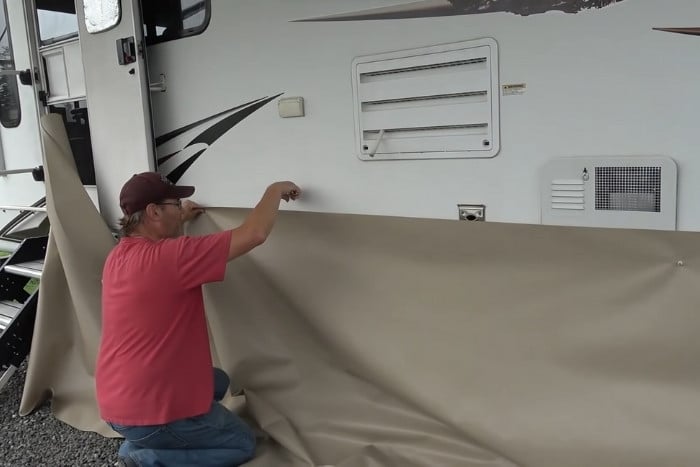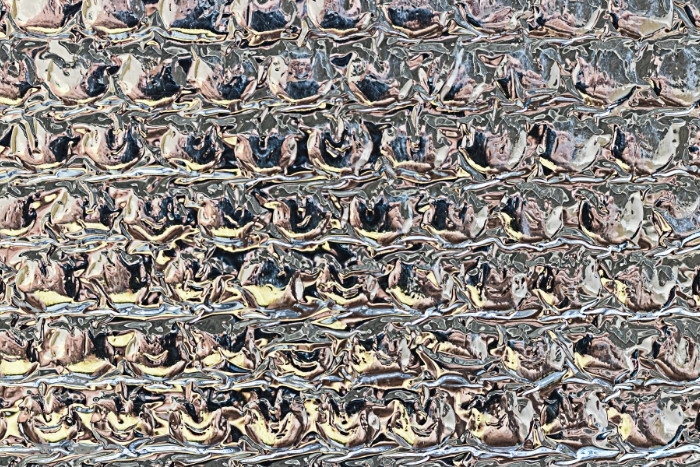Camping in your travel trailer in winter is an experience you don’t want to miss. The only thing holding you back might be the worry that your trailer won’t be warm enough to withstand the cold. Well, skirting your travel trailer makes a huge difference, and we are here to talk you through how to skirt a travel trailer for winter.
When skirting your trailer, you can choose to have a custom skirt made, or you can build the skirt yourself. Custom skirts are durable and reliable but expensive. DIY skirts made from foam boards, plywood, bubble foil, straw bales, snow, or vinyl can be cheap and accessible.
This article gives you a breakdown of what a travel trailer skirt is and why it’s important to have one for winter. We then analyze custom skirts and 6 DIY skirts to give you all the information you need to know about how they work and how effective they are against the cold.
Why Do You Need a Skirt For Winter?
Skirting underneath your travel trailer (or RV) is essential for any winter outing. The skirt is a protective material wrapped around the base of the trailer to shield and enclose the underside.
The skirting acts as a layer of insulation and protects exposed plumbing and prevents pipes or tanks from freezing in the winter. It also helps maintain a warm temperature inside your trailer instead of losing heat.
How Do You Skirt a Travel Trailer For the Winter?
There are several ways you can skirt a trailer; you can choose to have it custom-made or do it yourself.
In this article, we discuss what custom skirting can bring to your trailer and then give you 6 DIY ideas for winter skirting that are affordable and easy to set up.
Here, we discuss how to skirt your trailer with snow, vinyl, plywood, foam boards, straw bales, and bubble foil.
1. Custom
Custom skirting can offer you a reliable trailer skirt, measured to perfection, and normally comes with a couple of years’ warranty.
Custom skirting is usually made of heavy-duty vinyl, so it is durable in any season. Heavy-duty vinyl is thicker than normal vinyl, so it’s more insulating.
It will be easier to detach if you’re moving around during your winter trip.
The downside to custom skirting is the price; they usually range from $1000 to $3000, but it’s worth it for the quality and longevity it provides.

2. Straw Bales
Straw bales can be used to skirt your trailer for winter insulation. They are easy to fit and adjust to your trailer’s needs. Pick up a couple of bales and fit them nicely under your trailer.
They are also recyclable. Once you’re finished with them, you can give them to a farm nearby. There are two downsides to straw bales.
The first is that straw bales can be an enticing home for pests or mice, so it’s best to cover them with bags.
They are also highly flammable, so don’t have any open flames nearby, or your trailer is going up in smoke.
3. Plywood
Plywood is a common material for skirting. With plywood, you can create a sturdy and insulating skirting that is easy to assemble.
When attaching plywood, you will need screws and a screwdriver to keep it on your trailer. Once on, plywood is particularly durable, protecting your trailer in the winter and against any storms.
With plywood, you can paint or stain the exterior, so it doesn’t have to stick out where you’re camping. Since plywood is not very flexible, you must ensure the material is cut to measure.
Otherwise, you’ll have gaps that could lead to frozen pipes.
4. Vinyl
Usually, the custom skirting will come from vinyl, but you can make this skirting yourself without the expensive price tag.
You can use scissors to cut the vinyl to fit your trailer, which is pretty straightforward. You’ll just need to attach it with velcro.
You can also use recycled billboard vinyl to make this skirting cheaper and more eco-friendly.
You can attach grommets to the vinyl, making it easier to attach and detach from your trailer, making it a great option if you travel and remove your skirting quickly.
The only downside to vinyl is how insulating it is.
While it will protect the underneath of your trailer from rain, its flimsy structure can deteriorate in a storm, and it may also struggle to keep your trailer warm in temperatures below freezing.
5. Foam Board
Using foam board to create skirting for your trailer is inexpensive and easy to do. A bonus is that foam boards are extremely insulating compared to vinyl.
The air pockets within the foam will trap the warm air from your trailer and create a shield against the cold outside.
You just need to pick some foam boards up, cut them to size, and attach them to your trailer with aluminum tape. Foam boards can be flimsy, but you can reinforce them by putting plywood behind them.
It may take longer, but it will stop foam boards from flying off in a storm. A downside to foam boards is that they can be painful to attach to your trailer.
Sadly their shelf life is also limited as the foam will break apart after multiple uses.
6. Double Bubble Reflective Foil
Double bubble reflective foil is at the top of the insulation skirting game. Using bubble foil is generally inexpensive, and the flexible material makes it easy to mold around your trailer.
You just cut how much you need and make sure you use a double layer of foil over any gaps. You can use foil tape to attach it to the trailer, but remember, you may need a lot!
The foil is also reusable, so it’ll last several winters. The downside to bubble foil is that it’s not sturdy, so you’ll want to park your trailer somewhere sheltered, or you can attach it to a plywood layer underneath.

7. Snow
Although it may seem like a rogue idea, it’s the cheapest way to insulate your trailer if you’re camping where there is an abundance of snow that will stay snowy (and not melt).
This snow skirt can be made by compacting snow around the bottom of your trailer. Snow comprises 90-95% air, making it a fantastic insulating option.
Pockets of air within the snow will stop any cold from penetrating the underside of your trailer.
With snow, you want to ensure that you are not packing it too tightly under your trailer, as some ventilation will ensure the snow doesn’t freeze your pipes when it melts and refreezes.
Conclusion
This article looked at why travel trailer skirts are essential over winter. They keep you warm inside your trailer and reduce the chance of your pipes freezing.
We then examined 7 ways to skirt a travel trailer for winter. This included using a custom-made skirt, a DIY straw bale skirt, and even constructing a recycled vinyl skirt.
Whichever way you skirt your travel trailer, you will reap the benefits of a warmer winter inside.
